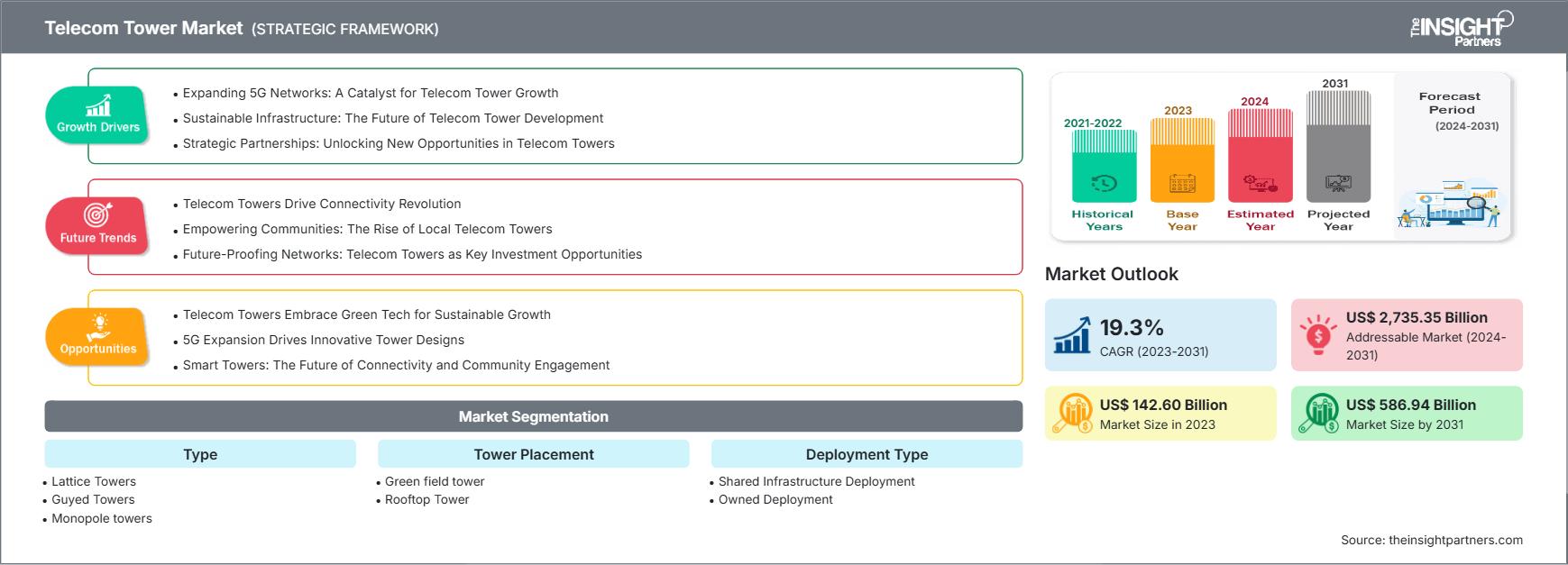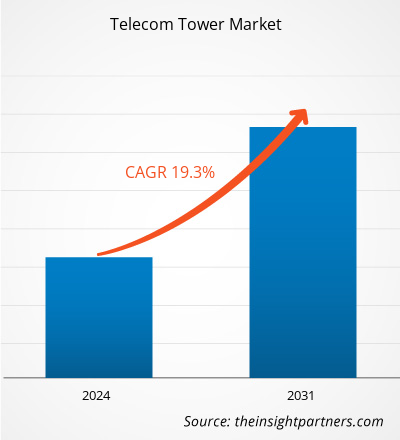Si prevede che il mercato delle torri per telecomunicazioni raggiungerà i 586,94 miliardi di dollari entro il 2031, rispetto ai 142,60 miliardi di dollari del 2023. Si prevede che il mercato registrerà un CAGR del 19,3% nel periodo 2023-2031. La crescita del mercato è trainata dall'estensione delle reti mobili nelle aree rurali, nonché dagli investimenti nella connettività 5G e nelle infrastrutture di telecomunicazioni.
Analisi del mercato delle torri per telecomunicazioni
Si prevede che il settore mondiale delle torri per telecomunicazioni trarrà vantaggio dalla crescente domanda di dispositivi a basso consumo energetico e dalla rivoluzione digitale nelle economie emergenti. Si prevede che le reti dati avanzate, tra cui 3G, 4G e 5G, miglioreranno il settore mondiale delle torri per telecomunicazioni nei prossimi anni. Si prevede che una maggiore collaborazione tra enti governativi e organizzazioni municipali guiderà la crescita del mercato globale delle torri per telecomunicazioni nei prossimi anni.
Panoramica del mercato delle torri per telecomunicazioni
L'industria mondiale delle torri per telecomunicazioni era in espansione a causa della crescente domanda di servizi di comunicazione mobile e wireless. Le torri per telecomunicazioni sono infrastrutture critiche per l'implementazione di reti wireless, come le tecnologie 4G e 5G. Le persone comunicano tramite torri per telecomunicazioni. Queste torri fungono da hub per tutte le antenne elettroniche, mobili, radiofoniche e televisive. L'insieme completo di apparecchiature di elaborazione del segnale elettronico e componenti meccanici che compongono una torre per telecomunicazioni viene utilizzato per connettere le persone tramite la comunicazione. Queste torri fungono da punto centrale per tutte le linee telefoniche e i servizi cellulari. Inoltre, le forze armate utilizzano queste torri per ospitare i radar. Torri di diverse altezze vengono utilizzate per una varietà di scopi e in luoghi diversi.
Otterrai la personalizzazione gratuita di qualsiasi report, incluse parti di questo report, analisi a livello nazionale, pacchetto dati Excel e potrai usufruire di fantastiche offerte e sconti per start-up e università.
Mercato delle torri per telecomunicazioni: approfondimenti strategici

- Scopri le principali tendenze di mercato di questo rapporto.Questo campione GRATUITO includerà analisi dei dati, che spaziano dalle tendenze di mercato alle stime e alle previsioni.
Driver e opportunità del mercato delle torri per telecomunicazioni
L'impennata delle comunicazioni mobili favorirà il mercato
Si prevede che l'utilizzo delle comunicazioni mobili guiderà la crescita futura del mercato delle torri per telecomunicazioni. La comunicazione mobile implica l'utilizzo di tecnologie come telefoni cellulari, smartphone e tablet per connettersi con persone in luoghi diversi. Le torri per telecomunicazioni, come quelle per la telefonia mobile, utilizzano apparecchiature elettriche e antenne per trasmettere e ricevere segnali, consentendo comunicazioni wireless su grandi distanze. A marzo 2023, l'Unione Internazionale delle Telecomunicazioni ha registrato un aumento del 5% della percentuale di popolazione mondiale maschile in possesso di telefoni cellulari, dal 74% nel 2021 al 79% nel 2022. Il crescente utilizzo delle comunicazioni mobili sta trainando la crescita del mercato delle torri per telecomunicazioni.
L'espansione guidata dal governo sta alimentando l'aumento delle torri per le telecomunicazioni
Si prevede che il settore delle torri per le telecomunicazioni si svilupperà grazie alle iniziative governative nel settore delle telecomunicazioni. Le iniziative governative per il settore delle telecomunicazioni includono politiche, programmi e attività volte a regolamentare, supportare e sviluppare il settore. Le attività governative nel settore delle telecomunicazioni hanno un impatto sulla situazione normativa, economica e tecnologica delle torri per le telecomunicazioni. L'Infrastructure Investment and Jobs Act del 2021 stanzia 65 miliardi di dollari per la banda larga, di cui 48,2 miliardi gestiti dal nuovo ufficio Internet Connectivity and Growth dell'NTIA. L'IIJA ha richiesto all'NTIA di sviluppare sei programmi per la banda larga, il più importante dei quali è il programma Broadband Equity, Access and Deployment (BEAD) da 42,45 miliardi di dollari. Pertanto, il mercato delle torri per le telecomunicazioni si sta espandendo grazie all'aumento degli sforzi governativi a favore del settore delle telecomunicazioni.
Analisi della segmentazione del rapporto sul mercato delle torri per telecomunicazioni
I segmenti chiave che hanno contribuito alla derivazione dell'analisi del mercato delle torri per telecomunicazioni sono la tipologia, il posizionamento della torre e il tipo di distribuzione.
- In base alla tipologia, il mercato delle torri per telecomunicazioni è suddiviso in torri a traliccio, torri strallate, torri monopolo, torri mimetiche e torri per telefonia mobile. Il segmento delle torri a traliccio deteneva una quota di mercato maggiore nel 2023.monopole towers, camouflage towers, and mobile cell towers. The lattice towers segment held a larger market share in 2023.
- DiPer quanto riguarda il posizionamento delle torri, il mercato è segmentato in torri greenfield e torri rooftop. Il segmento delle torri greenfield deteneva la quota maggiore del mercato nel 2023.
- In termini di tipologia di distribuzione, il mercato è segmentato in distribuzione di infrastrutture condivise e distribuzione di proprietà. Il segmento della distribuzione di infrastrutture ha dominato il mercato nel 2023.
Analisi della quota di mercato delle torri per telecomunicazioni per area geografica
L'ambito geografico del rapporto sul mercato delle torri per telecomunicazioni è suddiviso principalmente in cinque regioni: Nord America, Asia Pacifico, Europa, Medio Oriente e Africa e Sud America/Sud America e Centro America. Il Nord America ha dominato il mercato delle torri per telecomunicazioni. Il mercato statunitense è estremamente competitivo, con numerosi fornitori di rilievo che lottano per il predominio. Questa feroce rivalità è alimentata dall'elevata domanda di servizi di telecomunicazione 5G del Paese, che spinge molte aziende a concentrarsi sull'espansione delle proprie attività per sfruttare questa opportunità. Il governo degli Stati Uniti conta numerosi fornitori di spicco coinvolti in partnership, acquisizioni, fusioni, implementazioni e coalizioni. Negli ultimi anni, i servizi di telefonia mobile wireless si sono affermati come il settore delle telecomunicazioni più significativo e in rapida espansione del Canada. Si prevede che questa tendenza alla crescita continuerà con l'implementazione di tecnologie sofisticate come la rete 5G di quinta generazione , nonché di applicazioni innovative come l'Internet of Things (IoT).
Approfondimenti regionali sul mercato delle torri per telecomunicazioni
Le tendenze e i fattori regionali che hanno influenzato il mercato delle torri per telecomunicazioni durante il periodo di previsione sono stati ampiamente spiegati dagli analisti di The Insight Partners. Questa sezione analizza anche i segmenti e la geografia del mercato delle torri per telecomunicazioni in Nord America, Europa, Asia-Pacifico, Medio Oriente e Africa, America Meridionale e Centrale.
Ambito del rapporto sul mercato delle torri per telecomunicazioni
| Attributo del report | Dettagli |
|---|---|
| Dimensioni del mercato nel 2023 | 142,60 miliardi di dollari USA |
| Dimensioni del mercato entro il 2031 | 586,94 miliardi di dollari USA |
| CAGR globale (2023 - 2031) | 19,3% |
| Dati storici | 2021-2022 |
| Periodo di previsione | 2024-2031 |
| Segmenti coperti | Per tipo
|
| Regioni e paesi coperti | America del Nord
|
| Leader di mercato e profili aziendali chiave |
|
Densità degli operatori del mercato delle torri per telecomunicazioni: comprendere il suo impatto sulle dinamiche aziendali
Il mercato delle torri per telecomunicazioni è in rapida crescita, trainato dalla crescente domanda degli utenti finali, dovuta a fattori quali l'evoluzione delle preferenze dei consumatori, i progressi tecnologici e una maggiore consapevolezza dei vantaggi del prodotto. Con l'aumento della domanda, le aziende stanno ampliando la propria offerta, innovando per soddisfare le esigenze dei consumatori e sfruttando le tendenze emergenti, alimentando ulteriormente la crescita del mercato.

- Ottieni una panoramica dei principali attori del mercato delle torri per telecomunicazioni
Notizie e sviluppi recenti sul mercato delle torri per telecomunicazioni
Il mercato delle torri per telecomunicazioni viene valutato raccogliendo dati qualitativi e quantitativi a seguito di ricerche primarie e secondarie, che includono importanti pubblicazioni aziendali, dati di associazioni e database. Di seguito è riportato un elenco degli sviluppi del mercato:
- Nell'aprile 2023, TheIl governo indiano ha installato 254 torri mobili 4G nei villaggi LAC dell'Arunachal Pradesh. Inoltre, queste 254 torri forniranno connettività 4G a 336 comunità, comprese quelle rimaste senza connessione dall'indipendenza. La maggior parte di queste torri è posizionata nelle aree di confine con la Cina per impedire l'invasione delle telecomunicazioni straniere. Si stima inoltre che il lancio di questo programma aiuterà oltre 70.000 persone.
(Fonte: governo indiano, sito web aziendale, 2023)
- Nell'aprile 2023,Tawal, una sussidiaria di Saudi Telecom Company (STC), ha concordato l'acquisizione dell'infrastruttura delle torri di United Group per 1,22 miliardi di euro (1,34 miliardi di dollari). L'accordo comprenderà le unità infrastrutturali di United Group in Bulgaria, Slovenia e Croazia, per un totale di circa 4.800 torri. Inoltre, questa acquisizione strategica è coerente con l'obiettivo di Tawal di rafforzare la propria presenza internazionale in importanti paesi con un forte potenziale di sviluppo all'interno del Gruppo STC.
(Fonte: Tawal, sito web aziendale, 2023)
Copertura e risultati del rapporto sul mercato delle torri per telecomunicazioni
Il rapporto "Dimensioni e previsioni del mercato delle torri per telecomunicazioni (2021-2031)" fornisce un'analisi dettagliata del mercato che copre le seguenti aree:
- Dimensioni e previsioni del mercato a livello globale, regionale e nazionale per tutti i segmenti di mercato chiave coperti dall'ambito
- Dinamiche di mercato come fattori trainanti, vincoli e opportunità chiave
- Principali tendenze future
- Analisi dettagliata delle cinque forze PEST/Porter e SWOT
- Analisi del mercato globale e regionale che copre le principali tendenze del mercato, i principali attori, le normative e i recenti sviluppi del mercato
- Analisi del panorama industriale e della concorrenza che copre la concentrazione del mercato, l'analisi della mappa termica, i principali attori e gli sviluppi recenti
- Profili aziendali dettagliati
- Analisi storica (2 anni), anno base, previsione (7 anni) con CAGR
- Analisi PEST e SWOT
- Valore/volume delle dimensioni del mercato - Globale, Regionale, Nazionale
- Industria e panorama competitivo
- Set di dati Excel
Report recenti
Rapporti correlati
Testimonianze
Motivo dell'acquisto
- Processo decisionale informato
- Comprensione delle dinamiche di mercato
- Analisi competitiva
- Analisi dei clienti
- Previsioni di mercato
- Mitigazione del rischio
- Pianificazione strategica
- Giustificazione degli investimenti
- Identificazione dei mercati emergenti
- Miglioramento delle strategie di marketing
- Aumento dell'efficienza operativa
- Allineamento alle tendenze normative




















 Ottieni un campione gratuito per - Mercato delle torri per telecomunicazioni
Ottieni un campione gratuito per - Mercato delle torri per telecomunicazioni